story and photos by Kayte Deioma
 “You are standing at the crossroads of American Roots Music” are the words emblazoned under your feet as you step into the River Music Experience.
“You are standing at the crossroads of American Roots Music” are the words emblazoned under your feet as you step into the River Music Experience.
The River Music Experience (RME or RMX), provides a connection between the history of American music genres, the Mississippi River and the thriving music scene of today’s Quad Cities. This red brick building in downtown Davenport, Iowa, two blocks from the Mississippi river, is a café and live music venue downstairs, with a museum, bar and additional performance space up a wide open dual staircase.
 Mojo’s Café is an intimate corner in the front of the building separated from the first floor gallery by a stretch of hardwood floor designed to resemble the frets on a giant guitar. A stage in a windowed corner showcases local musicians for café patrons and provides an enticing view to the street to tempt passersby. If your timing is right, you might catch one of the lunchtime or evening performances that include poetry and theatre readings as well as scheduled music acts and an open mic night.
Mojo’s Café is an intimate corner in the front of the building separated from the first floor gallery by a stretch of hardwood floor designed to resemble the frets on a giant guitar. A stage in a windowed corner showcases local musicians for café patrons and provides an enticing view to the street to tempt passersby. If your timing is right, you might catch one of the lunchtime or evening performances that include poetry and theatre readings as well as scheduled music acts and an open mic night.
At the back of the first level is the ticket desk, gift shop and several walls of exhibit space for rotating exhibits.
 If there’s no music playing downstairs, you can always get an earful upstairs. Interactive multimedia “Ear Ports” let you don headsets and immerse yourself in whatever kinds of River Music interests you. From rockabilly to ragtime, gospel to blues, country to rock-n-roll, boogie-woogie to bluegrass, the history of American music is told in text panels, video clips and in the voices and instruments of the musicians who experienced the birthing pains.
If there’s no music playing downstairs, you can always get an earful upstairs. Interactive multimedia “Ear Ports” let you don headsets and immerse yourself in whatever kinds of River Music interests you. From rockabilly to ragtime, gospel to blues, country to rock-n-roll, boogie-woogie to bluegrass, the history of American music is told in text panels, video clips and in the voices and instruments of the musicians who experienced the birthing pains.
 You define your own listening and viewing experience by navigating your way with a track ball to select stories or music clips by region, by decade, by genre or by artist. If you’re the kind of person who gets sucked into all the music documentaries on PBS and the Learning Channel, you could be lost in here for days. There are over 300 interviews and 1000 audio files woven into the multimedia system.
You define your own listening and viewing experience by navigating your way with a track ball to select stories or music clips by region, by decade, by genre or by artist. If you’re the kind of person who gets sucked into all the music documentaries on PBS and the Learning Channel, you could be lost in here for days. There are over 300 interviews and 1000 audio files woven into the multimedia system.
 The role of riverboats in disseminating new music styles along the Mississippi River is thoroughly explored from the calliope to African American hot-dance jazz. Separate kiosks let you explore music history by regions. Learn about Sam Phillips and the Sun Studio in Memphis, or listen to Louis Armstrong talk about jazz in New Orleans. Since not all American musical development occurred along the Mississippi, there’s a station dedicated to “Beyond the River” as well.
The role of riverboats in disseminating new music styles along the Mississippi River is thoroughly explored from the calliope to African American hot-dance jazz. Separate kiosks let you explore music history by regions. Learn about Sam Phillips and the Sun Studio in Memphis, or listen to Louis Armstrong talk about jazz in New Orleans. Since not all American musical development occurred along the Mississippi, there’s a station dedicated to “Beyond the River” as well.
 Photos, record albums, musical instruments and other artifacts adorn walls and fill glass cases. A Wah Wah pedal alleged to have been used by Jimi Hendrix, is presented next to the program from his performance in Davenport. Nearby you’ll find Charlie Daniels’ fiddle bow, a saxophone autographed by Bill Clinton, and a 1986 Les Paul guitar signed by B.B. King.
Photos, record albums, musical instruments and other artifacts adorn walls and fill glass cases. A Wah Wah pedal alleged to have been used by Jimi Hendrix, is presented next to the program from his performance in Davenport. Nearby you’ll find Charlie Daniels’ fiddle bow, a saxophone autographed by Bill Clinton, and a 1986 Les Paul guitar signed by B.B. King.
 Significant real estate is rightfully given to 1920s jazz cornet phenomenon Bix Beiderbecke, for whom a Quad Cities jazz festival is named, as well as home-town music masters Francis Clay, Louis Bellson and Pat Patrick.
Significant real estate is rightfully given to 1920s jazz cornet phenomenon Bix Beiderbecke, for whom a Quad Cities jazz festival is named, as well as home-town music masters Francis Clay, Louis Bellson and Pat Patrick.
In addition to the exhibit space, the Redstone Room is a full bar upstairs open only for scheduled performances. The exhibit spaces are free to explore whenever the Mojo Café is open.
The River Music Experience
131 W. 2nd Street
Davenport, IA 52801
(563) 326-1333
(877) 326-1333 toll free
www.rivermusicexperience.org
?

 I am learning to navigate a sightless world at
I am learning to navigate a sightless world at  The student group has booked the short tour, so it is just Birgit and I who continue with our guide, Brita, out into the cool air, across a wobbly bridge onto a waiting boat. We can hear the water lapping and smell the sea air as we feel our way to a bench at the side of the boat.
The student group has booked the short tour, so it is just Birgit and I who continue with our guide, Brita, out into the cool air, across a wobbly bridge onto a waiting boat. We can hear the water lapping and smell the sea air as we feel our way to a bench at the side of the boat. Dialog im Dunkeln originated in Hamburg in 1988. Since then, they have created permanent or temporary exhibits in over 130 cities in 20 countries, providing more than 5000 jobs for the blind.
Dialog im Dunkeln originated in Hamburg in 1988. Since then, they have created permanent or temporary exhibits in over 130 cities in 20 countries, providing more than 5000 jobs for the blind.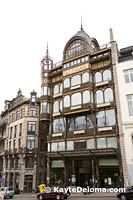 A true gem on the Mont des Arts in Brussels is the Musical Instrument Museum (MIM), home to one of the largest collections of musical apparatuses in the world. Founded in 1877 as part of the Royal Museums of Art and History, the museum moved into the former Old England department store, an 1899 masterpiece of Art Nouveau architecture, in 2000. Twelve hundred of the 7,000 instruments in the collection are on display at any given time.
A true gem on the Mont des Arts in Brussels is the Musical Instrument Museum (MIM), home to one of the largest collections of musical apparatuses in the world. Founded in 1877 as part of the Royal Museums of Art and History, the museum moved into the former Old England department store, an 1899 masterpiece of Art Nouveau architecture, in 2000. Twelve hundred of the 7,000 instruments in the collection are on display at any given time.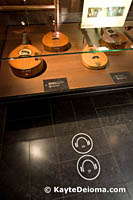 there was a printed English language guide to help you navigate the museum, but they were all out of them. You can still enjoy the museum without understanding the descriptions since included in the price of admission is an infrared audio tour that plays the music of over 200 of the instruments when you stand near the designated headphone icon.
there was a printed English language guide to help you navigate the museum, but they were all out of them. You can still enjoy the museum without understanding the descriptions since included in the price of admission is an infrared audio tour that plays the music of over 200 of the instruments when you stand near the designated headphone icon.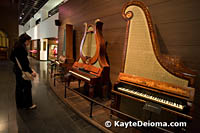 Listening to the rare and exotic instruments while admiring their artistry and craftsmanship becomes a more sensory experience when there’s no intellectual information to clutter the mind. You can experience the drone of Tibetan trumpets and the sinewy tones of serpent-headed Russian clarinets. In the keyboard section you can hear the difference between the harpsichords, spinets, virginals, clavicytheriums, clavichords and fortepianos.
Listening to the rare and exotic instruments while admiring their artistry and craftsmanship becomes a more sensory experience when there’s no intellectual information to clutter the mind. You can experience the drone of Tibetan trumpets and the sinewy tones of serpent-headed Russian clarinets. In the keyboard section you can hear the difference between the harpsichords, spinets, virginals, clavicytheriums, clavichords and fortepianos.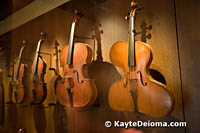 Strings are also well represented with the work of some the best known luthiers, as well as many one-of-a-kind creations. Examples of stringed instruments from five continents can be compared from ancient times to the present.
Strings are also well represented with the work of some the best known luthiers, as well as many one-of-a-kind creations. Examples of stringed instruments from five continents can be compared from ancient times to the present.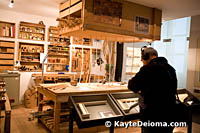 Restoration workshops for keyboards and stringed instruments are integrated into the exhibit galleries and show the tools and processes of instrument construction and repair.
Restoration workshops for keyboards and stringed instruments are integrated into the exhibit galleries and show the tools and processes of instrument construction and repair.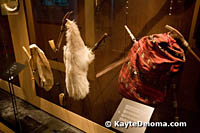 You can see a wide selection of brass horns developed by Belgian musician and inventor Adolph Sax, best known for designing the instrument that was to become known as the saxophone. In another direction, you’ll find the evolution of the bagpipe through different cultures around the world.
You can see a wide selection of brass horns developed by Belgian musician and inventor Adolph Sax, best known for designing the instrument that was to become known as the saxophone. In another direction, you’ll find the evolution of the bagpipe through different cultures around the world.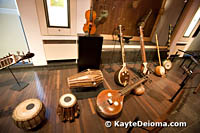 MIM offers a series of concerts in their auditorium. On the first Wednesday afternoon of the month, the museum is free to the public and also presents a selection of live musical presentations in the exhibit galleries. They also offer family concerts on the free Wednesdays.
MIM offers a series of concerts in their auditorium. On the first Wednesday afternoon of the month, the museum is free to the public and also presents a selection of live musical presentations in the exhibit galleries. They also offer family concerts on the free Wednesdays.